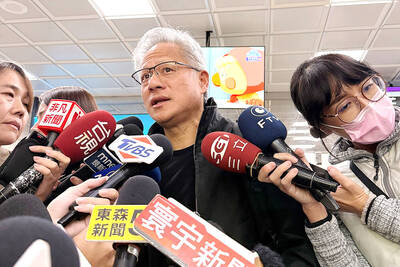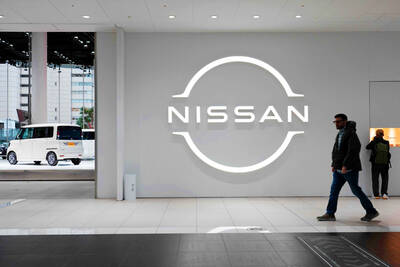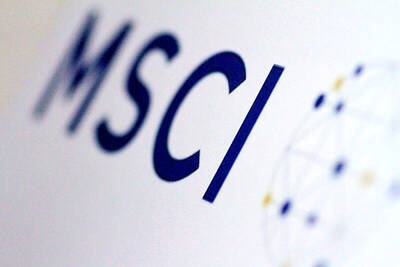Yoko Kojima loves zipping around Tokyo in her Daihatsu Tanto with its tiny wheels and pint-sized engine, but Japan’s beloved “kei cars” might have a rocky road ahead despite a legion of loyal fans.
Sales of the cutesy boxy cars, a staple of the world’s No. 3 vehicle market, drove off a cliff after peaking at 2.27 million units in 2014.
The drop to 1.72 million vehicles sold last year was a response by cost-conscious drivers as the government — looking to pay down a massive national debt — jacked up taxes on the popular made-in-Japan vehicles.

Photo: AFP
It was a nasty shock for many kei drivers, the majority of whom are women and those in rural areas where the little vehicles are indispensable for getting around on the cheap.
“I don’t see a bright future for kei cars,” IHS Markit analyst Yoshiaki Kawano said, adding that a consumption tax rise planned for 2019 could also dent kei sales.
“It’s an aging society and rural areas are losing residents — where kei cars are most popular,” he said.
There is no doubt that keis — short for kei jidosha (“light cars”) — still have plenty of fans who love their great fuel economy and modest price tag.
They make up more than one-third of the domestic market, with Honda Motor Co releasing the newest version of its top-selling N-Box kei car this week.
“You can maneuver the car even if the streets are really narrow,” said 75-year-old Kojima, whose Tanto doubles as a van for her part-time flower delivery business.
“It’s really easy to drive — I adore it,” she added.
Keis were born out of the ashes of World War II when the government of the fast-modernizing country was keen to get Japanese off of scooters or non-motorized transit and into economy cars.
These days, the plucky little vehicles are still restricted to a motor less than 660cc, about the same as the average motorbike.
They also cannot be wider than 1.48m, giving keis a comically narrow shape that makes them look like they could tip over on a tight corner.
Keis cost less to produce than conventional cars and sell for about US$6,000 less. They also have cheaper insurance and, until recently, much lower taxes.
While they are everywhere in Japan — as a second family car, a farmer’s pickup truck or even a police vehicle for neighborhood patrols — kei cars are a tough sell overseas.
Apart from their odd shape and sometimes peculiar names, such as the Suzuki Hustler and the Cappuccino, most would not comply with US or European crash standards, and their tiny engines would make any muscle car enthusiast howl with laughter.
With Japan’s changing demographics and little chance of success overseas, except in emerging markets, keis might never reclaim their peak, but some think the industry can put the brakes on falling sales.
“They won’t disappear from the landscape,” said Asako Hoshino, a vice president at Nissan Motor Co who oversees the company’s domestic vehicle market.
Hoshino cites Nissan’s acquisition of kei car specialist Mitsubishi Motors Corp last year as proof they still have value, while Toyota Motor Corp took back all of its stake in Daihatsu Motor Co, which leads the mini-vehicle market alongside Suzuki Motor Corp.
“Twenty years ago, cars were a symbol of success, but that is not necessarily the case today,” Hoshino said. “The trend now is to reduce the size.”
Producers are trying to boost keis’ appeal by putting more style and cutting-edge features into what have long been bare-bones vehicles.
“A decade ago, kei cars’ functions were very limited — they had a nerdy image,” said Abe Shuhei, who works in Daihatsu’s sales planning division.
“But, bit by bit, people are starting to buy them now by choice, because they’re energy efficient, safe and stylish,” Shuhei said.

PERSISTENT RUMORS: Nvidia’s CEO said the firm is not in talks to sell AI chips to China, but he would welcome a change in US policy barring the activity Nvidia Corp CEO Jensen Huang (黃仁勳) said his company is not in discussions to sell its Blackwell artificial intelligence (AI) chips to Chinese firms, waving off speculation it is trying to engineer a return to the world’s largest semiconductor market. Huang, who arrived in Taiwan yesterday ahead of meetings with longtime partner Taiwan Semiconductor Manufacturing Co (TSMC, 台積電), took the opportunity to clarify recent comments about the US-China AI race. The Nvidia head caused a stir in an interview this week with the Financial Times, in which he was quoted as saying “China will win” the AI race. Huang yesterday said

Nissan Motor Co has agreed to sell its global headquarters in Yokohama for ¥97 billion (US$630 million) to a group sponsored by Taiwanese autoparts maker Minth Group (敏實集團), as the struggling automaker seeks to shore up its financial position. The acquisition is led by a special purchase company managed by KJR Management Ltd, a Japanese real-estate unit of private equity giant KKR & Co, people familiar with the matter said. KJR said it would act as asset manager together with Mizuho Real Estate Management Co. Nissan is undergoing a broad cost-cutting campaign by eliminating jobs and shuttering plants as it grapples

The Chinese government has issued guidance requiring new data center projects that have received any state funds to only use domestically made artificial intelligence (AI) chips, two sources familiar with the matter told Reuters. In recent weeks, Chinese regulatory authorities have ordered such data centers that are less than 30 percent complete to remove all installed foreign chips, or cancel plans to purchase them, while projects in a more advanced stage would be decided on a case-by-case basis, the sources said. The move could represent one of China’s most aggressive steps yet to eliminate foreign technology from its critical infrastructure amid a

MORE WEIGHT: The national weighting was raised in one index while holding steady in two others, while several companies rose or fell in prominence MSCI Inc, a global index provider, has raised Taiwan’s weighting in one of its major indices and left the country’s weighting unchanged in two other indices after a regular index review. In a statement released on Thursday, MSCI said it has upgraded Taiwan’s weighting in the MSCI All-Country World Index by 0.02 percentage points to 2.25 percent, while maintaining the weighting in the MSCI Emerging Markets Index, the most closely watched by foreign institutional investors, at 20.46 percent. Additionally, the index provider has left Taiwan’s weighting in the MSCI All-Country Asia ex-Japan Index unchanged at 23.15 percent. The latest index adjustments are to